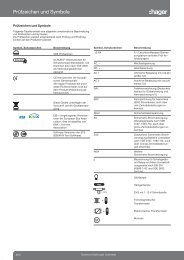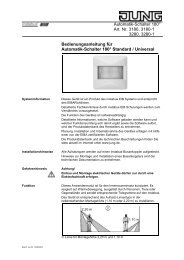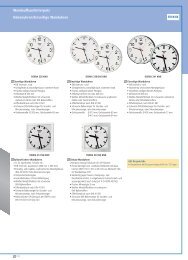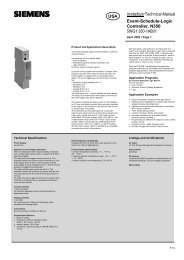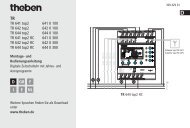Create successful ePaper yourself
Turn your PDF publications into a flip-book with our unique Google optimized e-Paper software.
i To be able to place an arm command in areas for which an arming delay has been configured,<br />
even in the "Not ready" status, the "Arm" button of the appropriate arming circuit<br />
remains visible on the system page of the signalling system even in the "Not ready" status.<br />
Unarming:<br />
In the "Armed" status, the system can be unarmed at any time. To do this, either the "Unarm"<br />
button must be pressed on the panel or a switching device must be set to "Unarmed". The system<br />
then switches to the "Unarmed" status immediately.<br />
If an alarm has occurred, then an Unarm command will reset the alarm (deactivation of the internal<br />
siren) and switch to the "Unarmed after alarm" status. If there is an alarm delay, then unarming<br />
within the elapsing delay time (prealarm) will prevent a alarm from being triggered (see<br />
chapter 4.2.4.12.4. Alarms).<br />
i The following always applies: if there is internal arming or an internal arming delay is<br />
elapsing, then external arming is not possible. Internal unarming must take place and then,<br />
if the system is ready to arm, external arming is possible. The reverse is true in like manner.<br />
i The signalling system only reacts to an arming or unarming command, when a system<br />
status change is possible (Unarmed -> Armed / Armed -> Unarmed /<br />
Alarm -> Unarmed after alarm). Repeating telegrams (Armed -> Armed /<br />
Unarmed -> Unarmed - e.g. for KNX/EIB switching units with cyclic transmission) are ignored<br />
by the signalling system.<br />
i Arming or unarming is saved in the event memory along with the date and time (if necessary,<br />
only after the arming delay has elapsed) (see chapter 4.2.4.12.6. Event memory).<br />
Signalling during arming/unarming<br />
In the case of external arming, the signalling system can confirm its status change "Unarmed" to<br />
"Armed" via the visual signal encoder output ("acknowledge"). This means that it is possible to<br />
detect clearly whether the system has responded to an arm command as required or not. This is<br />
primarily important when the system is operated remotely (without being to see the panel) or in<br />
the case of an arming delay. The visual signal encoder will not give a special acknowledgement<br />
on unarming. The signal encoder is also not controlled for internal arming.<br />
Whether the visual signal encoder is controlled in the case of external arming can be configured<br />
in the ETS plug-in using the parameter "Visual acknowledgement on external arming" in the<br />
parameter node of the signalling system. This means that it is possible to switch visual feedback<br />
off.<br />
In addition, various signals are available to signal the status of the signalling system. These signals<br />
are 'run out' using separate KNX/EIB 1 bit objects and can be tapped.<br />
The following objects can be planned in the signalling system node in the ETS plug-in...<br />
- "Ready to arm, internal" and "Ready to arm, external":<br />
These objects signal the readiness of the assigned security areas separately for internal or<br />
external arming. If the areas are ready for arming, the object value is "1". If they are not<br />
ready, the object value is "0".<br />
When the system is armed (no matter whether internally or externally), both objects switch<br />
back to "0", irrespective of which status is displayed on the signalling system page on the<br />
panel.<br />
- "Arming message, internal" and "Arming message, external":<br />
These objects signal whether the appropriate security areas are armed or unarmed separately<br />
for internal or external arming. Signalling is static for the length of the status. An<br />
object value "1" means "Area(s) armed", whilst an object value "0" means<br />
"Area(s) unarmed". "Unarmed" is signalled in the system status "Unarmed after alarm".<br />
Order-No. 7574 00 1X<br />
Software "...590101"<br />
Functional description<br />
Page 120 of 222






